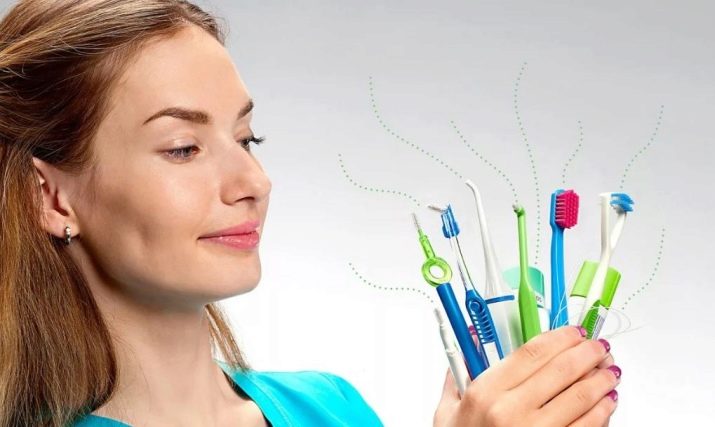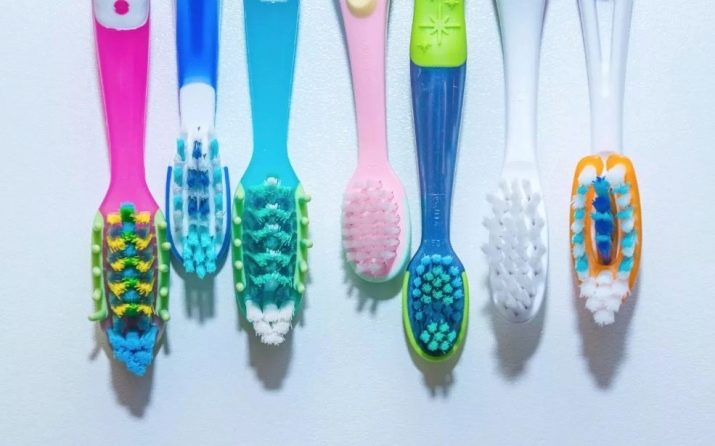How to choose a toothbrush according to the degree of hardness?

Today hardly anyone doubts the need for careful daily oral care. The health of teeth is influenced not only by the degree of diligence in performing the generally accepted manipulations, but also by the quality of the instruments used. An incorrectly chosen type of toothbrush in terms of hardness can actually be the main culprit in the occurrence of many dental diseases.

Stiffness options
The ancient prototype of the modern toothbrush appeared 300-400 years before the new era. In those days, twigs of some tree species were used to brush teeth, the ends of which were softened, getting a kind of broom. In Egypt, Greece, Rome and Babylon, after applying a broomstick, special healing compounds were rubbed into the gums. In India, they used a special stick. The real brush was invented in China (XV century), when to bamboo? pork bristles were attached to the stick.
In the 16th century, this essential hygiene item penetrated Europe, where the handles were already wooden, and they were equipped with more delicate badger bristles or horsehair.
Nevertheless, toothbrushes finally "took root" among Europeans only in the 18th century, when the doctor P. Fochard published a famous work on dentistry, in which a large chapter was devoted to the intricacies of dental care.


The patent for the brush appeared in 1850 in the USA, when H.N. Wodsworth invented a high-quality fastening of the bristles to the handle. However, brushes were then made from natural materials, which made it possible for microbes to appear in the oral cavity.
The problem was solved only in 1938 - the chemical company DuPont began using the nylon fibers it obtained for bristles.
Since then, it has become possible to classify brushes according to the degree of hardness (indicated on the packages).
In any case, the hairs on the brushes are grouped into bundles located at different levels (from 1 to 3) or at an angle to each other. On some models, different heights of bristles perform different functions.
Some manufacturers group villi of different degrees of rigidity in products, placing, for example, hard ones in the center (for better cleaning of the chewing part of the teeth), and soft ones on the sides (for gentle cleansing of the edges of the gums).



In addition to the stiffness of the bristle, the nuances of its processing are also relevant. A significant part of the products manufactured today have a rounded end of the villi so as not to injure the gums. Pointed bristles often damage soft tissue.

The modern industry produces different types of toothbrushes, each of which has its own pros and cons.
- Sensitive. Sensitive are extremely soft products that are gentle for the teeth, used for inflammation on the inner side of the oral cavity. The use is recommended for acute dental diseases (gingivitis and periodontitis).
- Soft. Soft (soft). A product for children who are just starting to brush their teeth. Suitable for adults with gum inflammation (periodontitis, gingivitis).
- Medium. Medium (medium). For people without dental defects and pathology.
- Hard. Hard (hard). Such brushes are not suitable for everyone, but for people without non-carious defects in external tissues and with an excellent state of the oral space. They do an excellent job of removing plaque.
- Extra Hard. Extrahard (extremely hard) - for people with extremely strong teeth. If defects appear on the gums or blood, it is worth switching to softer brush options.


Types of bristles
There are two types of bristles: natural and synthetic.
Natural
We often think that natural is better than artificial, but not in this case. Since natural bristles have more disadvantages than advantages.
More recently, natural bristle toothbrushes were extremely popular. Nowadays, such brushes are less and less common on the market.
Natural villi have a porous structure and a channel where bacteria accumulate and multiply. In addition to this, they are tough, capable of severely scratching the gums.
In natural fibers, the ends cannot be rounded, and they gradually delaminate. Synthetic fibers are rounded and polished - these fibers clean more effectively.

But natural products also have their advantages.
-
High-quality natural bristles, for example, pork bristles, are more suitable for cleaning especially sensitive teeth, since they have a soft structure, teeth and gums will not be damaged. Therefore, such a brush is great for children, and will also be useful in the fight against periodontitis.
-
Natural fibers are able to withstand temperatures up to +80 degrees, which contributes to a longer preservation of their shape by the bristles.
-
Natural fibers do not leave scratches on the enamel and polish teeth more effectively.
Choose a toothbrush with the type of bristle that's right for you. After all, preference depends on the condition of your teeth and gums. Better, of course, to rely on the opinion of the dentist, which will help you make a better choice.


Synthetic
Artificial brushes are made from:
-
nylon;
-
setron;
-
perlon;
-
derolone;
-
polyurethane;
-
mixed;
-
combined.
Artificial bristles are even, without pores, dry out soon and are less colonized by bacteria, and therefore are considered safer.
Artificial villi are softer and during cleaning do not strongly affect enamel and gums. Synthetic bristles are easier to disinfect.


In the production of bristles of various hardness, fibers of various diameters are used:
-
the softest nylon bristles with a fiber diameter of 0.15-0.18 mm;
-
soft - up to 0.2 mm;
-
medium - up to 0.22 mm.
Usually, brushes use one pile thickness, but there are also products with fibers of different hardness. Tufts of villi can be multilevel. With the development of technology, brushes began to be produced with additional useful qualities that simplify brushing your teeth.
In bristles with a rubberized texture, layers of polymers are used, based on nano-spraying, which forms a layer of microvilli on the pile along the length, which significantly increases the working conditions of individual villi. This allows you to more efficiently remove plaque, polish the surface layers of the teeth, and refresh their enamel.

Fine-tipped bristles are designed for productive cleaning of interdental gaps. Thinned tips of the villi (0.01-0.02 mm) go deeper into the spaces of the dentition than the bristles of conventional brushes, increasing the productivity of cleaning in not quite accessible areas.
Bristles with charcoal are produced in compliance with special technological methods of processing raw materials, they do not absorb moisture and grains of paste. Due to this, the brushes keep their qualities longer. The layer of activated carbon, which is part of the villi, absorbs bad odors, which significantly freshens breath. Bristles with bamboo have similar qualities.


Spiral-shaped villi are produced by twisting two or more fibers, due to which they receive a certain roughness along the length. For this reason, not only the end of the villus is involved in the cleaning process, but also its other parts, which increase the productivity of the entire process.
The tips of modern bristles are rounded or tapered to increase safety and penetration.
The next step towards improving the brushes was the production of ultra-micro-tips of the villi that do not deform the gum tissue. It also uses the inclusion of antibacterial components in the polymer layers of the bristles.
Recently, scientists have developed and implemented microtextured bristles for brushes. Here it was possible to significantly increase the texture area of individual bristles (from 97 A0 to 329 A0), which made it possible to more thoroughly and completely clean the teeth. The micro-texture of such villi is identical to the micro-texture of the layers of tooth enamel, which significantly increases their cleaning efficiency.
The latest achievement is products with silicone projections that replace nylon villi, and a special elastomer plate built into the brush perfectly cleans teeth from plaque.




How to choose?
In case of damage to the dental tissues, it is better to dwell on non-rigid versions of products (sensitive, software).
In case of diseases with concomitant loosening of the teeth and enamel defects, soft brush options are also suitable. The same degree of stiffness will be appropriate for bleeding gums. You should not use soft options if there are no obvious reasons for this - the productivity of cleaning will be reduced.
Medium products are the most popular for healthy mouth tissues.
Hard brushes are recommended for smokers and coffee lovers, as well as for users with persistent dental plaque. It is recommended to use such brushes for people with healthy teeth and strong enamel. If these recommendations are violated, unpleasant consequences are possible.


Extrahard brushes are already specialized options used for cleaning removable dentures or fixed bridges and braces. They are also suitable for people with perfect dental performance and excellent enamel. However, the practice of using them should be distinguished by caution, and if bleeding occurs, they should be replaced with softer options.
Do not use very hard brushes, ignoring medical advice. Can you get injuries and abrasion of hard dental tissues?

To avoid damage to the gums when brushing your teeth, it is better to purchase products with smooth contours of transitions and many bundles of villi with rounded ends.
Understandably, brushes made with man-made fibers are better. Natural bristles absorb moisture intensively, creating a favorable bacterial environment. They also break, causing sharp edges to damage the gums.
For everyday use, brushes with short working parts (2-2.5 teeth) are better suited.
Electric and ultrasonic products make it easier to brush your teeth, but they should be used with caution, using up to 3 times a week. Failure to do so increases the chances of tooth wear and gum injury.


It is preferable that your brush has a special pad for cleaning the tongue, where bacterial plaque often occurs. When choosing a product, it is important to consider not only the degree of its rigidity, but also the height of the villi.
There is a well-known selection of brushes:
-
single-level;
-
two-level;
-
three-level;
-
multilevel.
The more complicated the "drawings" of the working areas of the products, the more efficiently they remove layers from the enamel coating.
If your teeth are healthy, use the first two levels of brushes. With uneven dentition or large interdental distance, it is preferable to choose 2-3-level bristles. Multilevel products are used when cleaning braces.
When purchasing a brush, evaluate the ergonomics of the entire structure, how comfortable it is. Inconvenient grip on the brush affects the quality of cleaning.



When should you change?
The condition of the teeth is not a constant value, therefore, the criteria for choosing brushes should be revised. The product should be as close as possible to the current state of your dental health.
Due to the technological features of cleaning and the degree of wear, the brushes must be replaced from time to time. Such a replacement, according to a number of dentists, should be done at least once every 3 months. Practice convincingly shows that products of the medium type are used within 3 months, and of the soft type - no more than 2 months.

Control over the brush should be carried out constantly, since as it is applied, the bristles fall out, they are deflated, and the beams are thinned.









